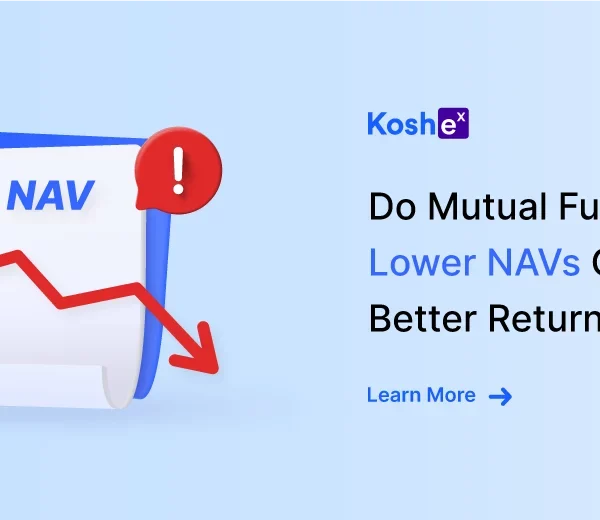Introduction
Is NAV Value Important In Choosing Mutual Funds?
When investing in a mutual fund, there are several factors to consider. One factor is the Net Asset Value (NAV), which keeps fluctuating based on the fund’s performance.
Understanding the significance of a mutual fund‘s NAV, how it is calculated, and how investment timing affects NAV is essential. In this blog, we will discuss all aspects of NAV and how signing up with Koshex can help gain deeper insights into these topics.
What is the NAV of a mutual fund?
All mutual funds have securities and liabilities. The value of the entire fund is determined by subtracting total liabilities from the securities.
This amount is then divided by the total number of units held by investors, which results in Net Asset Value (NAV), the intrinsic value per unit of the mutual fund.
The NAV is calculated at the end of each business day. One unit can be likened to a share on the stock market. The trajectory of a mutual fund‘s NAV over a period reflects how the fund has performed during that timeframe.
Purchase price of mutual fund and NAV
When investing in mutual funds, the price we pay depends upon the current NAV of the mutual fund. For instance, if the NAV is INR 15 and we plan to buy 50 units, then the cost price will be INR 750.
Hence, the cost of the mutual fund is calculated in terms of the price we pay for each unit. However, there are some additional charges, such as entry load, and the fee charged if one invests via a Demat platform.
NAVs of a new fund offering (NFOs)
The NAV of an NFO is fixed based on the quality and value of the underlying portfolio. NAVs of NFOs can start as low as INR 10, and keep growing as the fund’s performance improves. We may observe that the NAV of some NFOs is also much higher in value.
So, which should we choose – the mutual fund with the lower or higher NAV? This choice cannot be made merely by looking at the price of each unit. We should consider the quality of the underlying portfolio it represents and some additional factors, which will determine the potential of the fund to perform well.
For instance, it is better to invest in 5 units of a mutual fund whose NAV is INR 100 and is likely to perform well, than 15 units of a mutual fund whose NAV is INR INR 10 but is not likely to perform well.
Now, how do you know which fund will perform well? This is where additional research connected to the fund manager’s previous performance, the overall track record of the asset management company (AMC), and the mutual fund’s portfolio itself, can determine which will be the better bet.
Investors must also remember that the profits earned are impacted by another factor i.e. the expense ratio. This is a fee charged by the fund to manage it strategically. Higher returns earned by a fund with a lower expense ratio translate to a higher profit.
NAV’s relevance to investors
What do we consider more important when buying any commodity – price or value? If the price is very low, but the product does not deliver value, it will not be worth the price.
The same formula applies while investing in mutual funds. The success of a mutual fund lies in its ability to deliver returns.
This is not determined by the price we pay for each unit i.e. the NAV, but by the ability of the NAV to grow over time. Hence, investors must not buy a mutual fund merely because its NAV is lower, which translates to it appearing to be cheaper.
Consider aspects such as investment time horizon, financial goals, and risk appetite. However, the NAV’s trajectory over time indicates the fund’s growth and stability. Consistent NAV growth and its ability not to plummet during a market crash is a good sign.
NAV vs market price
Mutual funds function differently from the stock market. One major difference is how the price of a unit and share is calculated.
The market price of a share fluctuates based on the demand and supply of the company’s stock. It depends on additional factors such as the announcement of dividends, and the financial performance of the company.
News about the company, including employee layoffs, mergers and acquisitions, as well as fraudulent practices, can also play a major role.
The NAV of a mutual fund, which is the price per unit, is determined by the AMC. It is based on the closing market prices of the assets it owns, the value of its liabilities, and the total number of units.
How AMCs calculate daily NAV
There are three factors at play when an AMC calculates the daily NAV after trading hours. These include the closing market price of total assets held by the company, the total value of liabilities, and the total number of units.
The formula is as follows:
NAV = (Total Assets – Total Liabilities) / Total Number of Units
Assets of a mutual fund can include a mix of equity, debt instruments, debentures, bonds, commercial paper, and money market instruments. The mix of securities depends on the strategy of the mutual fund to earn returns.
How NAV Affects Your Mutual Fund Investment
Once we decide which mutual fund to invest in and our investment budget, the NAV affects the number of units purchased. Here are some examples:
- If we are investing INR 12,000, and the NAV is INR 120 per unit, then we will get 100 units
- If we are investing INR 5000 and the NAV is INR 10 per unit, then we still get 100 units
- If we are investing INR 20,000 and the NAV is INR 135 per unit, then we get 148 units
Two factors affecting NAV
Keep these additional factors in mind.
- The NAV applied depends on the time and date on which the AMC receives our investment funds. For instance, if the funds hit their account before 3 pm on August 10, 2022, then the NAV of August 10, 2022, applies.
- However, if the funds are received after 3 pm on August 10, 2022, then the NAV of the next day will apply.
- NAV differs based on whether we purchase it directly from the AMC or via a depository participant such as an investment platform, broker or agent. The latter, i.e. regular plans, come with certain additional fees, which leads to a lower NAV.
- On the other hand, NAVs of direct plans are always higher. Hence, taking the do-it-yourself route results in a higher NAV.
In conclusion
When investing in mutual funds, investors must remember that their NAV cannot be judged in isolation.
NAV is a measure of how the fund is performing in the context of the value of its securities, liabilities, and total outstanding units. The NAV can fluctuate every day.
Hence, investors can track the NAV over a period of time to understand how the fund has performed. Additionally, investors must take into consideration their investment time horizon, their wealth-creation goals, the fund’s expense ratio, and their investment budget, before making a decision.
It helps to start the investment journey by opening an account with a safe and secure online investment platform like Koshex for valuable guidance on how to invest based on risk profile and for a secure, transparent experience.
FAQs
Q. What is the importance of NAV in mutual funds?
A. NAV is critical as it determines the worth of one share of the fund.
Q. Can I still invest if NAV is low?
A. Most financial advisors opine that low or high NAV is irrelevant for the investors.









Leave a Comment